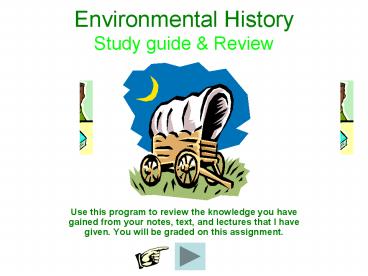Environmental History Study guide - PowerPoint PPT Presentation
1 / 29
Title:
Environmental History Study guide
Description:
Use this program to review the knowledge you have gained from your notes, text, ... A. Fortification. B. Slash & Burn. C. Signals. D. Lousing. Correct ! ... – PowerPoint PPT presentation
Number of Views:76
Avg rating:3.0/5.0
Title: Environmental History Study guide
1
Environmental HistoryStudy guide Review
- Use this program to review the knowledge you have
gained from your notes, text, and lectures that I
have given. You will be graded on this
assignment.
2
For the Duration of the class you will do the
following
- Precede through the selected material, and anwser
as many questions as you possibly can. If you
have trouble with one of the questions, please
make an educated guess and proceed. - If You get a question wrong it would be in your
best intrest to click the review button for the
selected material. - Once you have reread the selection click on
the back button and you can attempt to answer the
question again. - After you get the question correct and feel you
know the material please click the next button to
proceed to the next question.
3
- Sorry, That is incorrect. Please Try again, or
click on the help icon for further review.
4
Question 1
- Around 180 million years ago a huge land mass
known as ________ began to break apart. - Pangaea
- Laramide
- Glaciations
- Epoch
5
- Correct !
- Please move on to the next question
6
- Sorry, That is incorrect. Please Try again, or
click on the help icon for further review.
7
Question 2
- What event caused the extinction
- of the great predators across the Bering
Straight through North America. - Earthquake
- Continental Drift
- Pleistocene Epoch
- Milankovitch Cycle
8
- Correct !
- Please move on to the next question
9
Pleistocene Epoch
- When the Paleo-Indian arrived on the Great
Plains, they found it teeming with large mammals,
so called megafunga. Do to the Pleistocene Epoch
in where severe points of change in global
climate, caused extreme cold like that of an Ice
age. They were all driven to extinction
10
Milankovitch Cycle
- Named after a geophysicist back in the 1920s. He
observed, the earths orbit around the sun
changes, sometimes placing the planet closer to
the star, where it can receive more heat, and
sometimes further away, making the climate colder
and producing a glaciations.
11
Pangea
- American history began some 180 million years ago
when the earths only continent, a huge land mass
known as Pangaea, began to break apart. At first
Pangaea split into two parts. As the Atlantic
expanded, North America separated from Africa. By
about 60 million years ago, North America was
born.
12
Laramide Orogeny
- The creation of the mountains beginning around 80
million years ago is known as the Laramide
Orogeny. The Great Plains were a tremendous
inland sea, the emergence of the mountains,
however, plugged the waters entry from the
Pacific and Artic oceans, creating conditions
favorable of forest cover on the plains.
13
Slash Burn
- The Indian were the first to use this technique
to clear vast landscapes, altering there
environment to fit their needs. They did this for
a number of reasons mosquitoes, fleas, hunting
parties as well as travel. Although the Europeans
intensified the process it began long before
European contact.
14
- Sorry, That is incorrect. Please Try again, or
click on the help icon for further review.
15
- Correct !
- Please move on to the next question
16
- Sorry, That is incorrect. Please Try again, or
click on the help icon for further review.
17
Question 3
- This observable phenomenon is where the earths
orbit around the sun changes, sometimes placing
the planet closer to the star, is referred to as
the _________. - Glaciations
- McCormic event
- Milankovitch cycle
- Ecological Niche
18
- Correct !
- Please move on to the next question
19
- Sorry, That is incorrect. Please Try again, or
click on the help icon for further review.
20
Question 5
- The emergence of mountain ranges, and the later
forest cover of the Great Plains was attributed
to the __________. - Laramide Orogeny
- Plate convergence
- Mineral displacement
- Breadbasket
21
- Correct !
- Please move on to the next question
22
- Sorry, That is incorrect. Please Try again, or
click on the help icon for further review.
23
Question 4
- The Indians used this technique
- First to make travel and hunting
- Easier, as well as a defense against
- Fleas and mosquitoes.
- A. Fortification
- B. Slash Burn
- C. Signals
- D. Lousing
24
- Correct !
- Please move on to the next question
25
- Sorry, That is incorrect. Please Try again, or
click on the help icon for further review.
26
Question 6
- The first colony to settle in North America was
the _________ colony. - Jamestown
- Roanoke
- Plymouth
- Towson
27
- Correct !
- Please move on to the next question
28
Roanoke
- In 1587, Sir Walter Raleigh,
- the English courier and
- navigator, recruited 117 people men, women,
and children to venture to the New World. Their
destination was off the coast of North Carolina
now named Roanoke Island. With war in Spain
delaying returns, when new settlers arrived it
was a Lost Colony.
29
Congratulations!
- You have completed the assignment. You may use
this as a study guide for your test.































